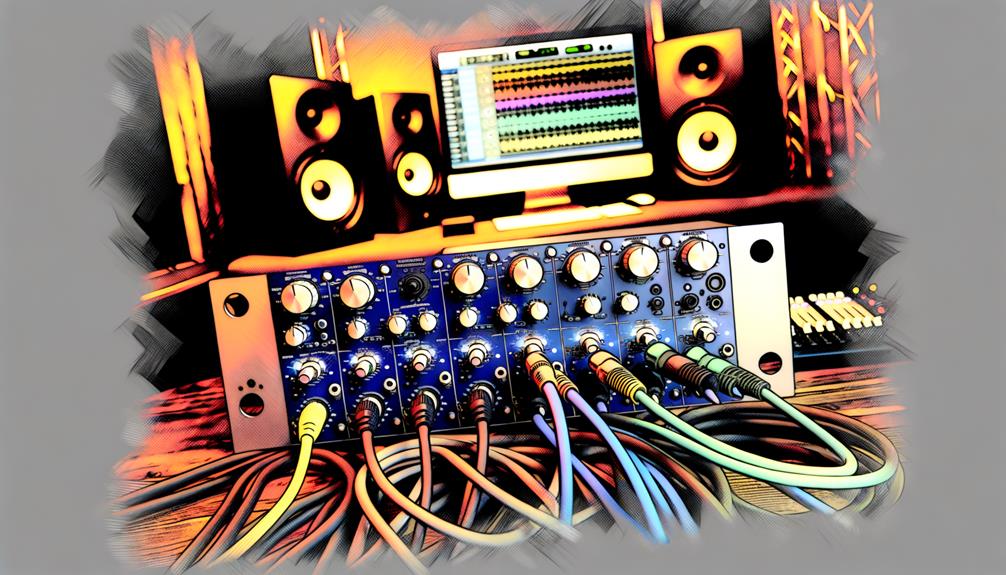No products in the cart.
In the sophisticated discipline of music production, the calibration of input gain and the adept use of in-the-box techniques are elements that can distinguish a well-crafted mix from an amateur endeavor. Properly adjusted input gain not only ensures optimal signal levels but also lays the foundation for a clean and dynamic recording, a prerequisite for high-quality sound.
Meanwhile, the in-the-box approach to production offers an expansive array of tools and effects that, when skillfully applied, can elevate a project to professional standards. However, navigating the myriad options available within a digital audio workstation requires not only technical knowledge but also a keen sense of creativity and innovation.
In the following discourse, we shall investigate the nuances of these methodologies and their implications for the audio production process, highlighting the importance of precision and artistry in this digital age. The forthcoming analysis promises to elucidate strategies that both novices and experts may integrate into their workflows to achieve sonic excellence.
Contents
hide
Key Takeaways
- Properly adjusting input gain is crucial to avoid irreversible distortion in the signal.
- Hot input gain in analog gear can produce pleasing distortion effects.
- The order of plug-ins in the signal chain can significantly impact the overall sound.
- In the box production offers convenience and the ability to recreate previous mixes, but mixing without external hardware can be challenging.
Understanding Input Gain

Why is it crucial for music producers to meticulously adjust input gain?
Precise input gain configuration is the linchpin in the quest for optimal sound fidelity. It determines the signal strength coursing through the audio processing chain, impacting the texture and clarity of the final output.
What are the consequences of neglecting this fundamental step?
Neglecting the adjustment of input gain can have detrimental effects on the quality of the audio. Exploring distortion effects can be artistically rewarding when done intentionally; however, unintended overloading spawns clipping distortion—a bane that truncates audio peaks, yielding harshness and compromising the integrity of the sonic landscape.
Innovators in music production recognize that avoiding clipping distortion through judicious gain staging sets the foundation for a pristine and dynamic mix, essential for transcending conventional auditory experiences.
https://musictech.com/guides/essential-guide/a-z-music-making-i/
Utilizing Inserts Effectively
Having established the critical role of input gain in shaping the audio signal, it is equally important to master the use of inserts, as they offer precise control over the signal processing chain in both hardware mixers and digital audio workstations.
Using inserts creatively can transform a mix from mundane to mesmerizing. Maximizing the potential of in-the-box production relies heavily on strategic insert application. Here’s how to optimize your use of inserts:
- Signal Flow Optimization: Arrange your inserts to flow logically from dynamic control to tone shaping to spatial effects.
- Creative Layering: Use parallel processing to blend clean and effected signals for depth and punch.
- Surgical Precision: Insert utility plugins, like EQs and compressors, for targeted tweaks without affecting the entire track.
Choosing the Right Audio Interface


Selecting an appropriate audio interface is a pivotal decision in any music production setup, as it directly impacts the fidelity and character of your recordings. When dissecting audio interface features, scrutinize the preamps’ quality, bit depth, and sample rates offered. These specifications will be clear indicators of the potential clarity and definition your interface can impart to your soundscape.
Moreover, latency performance should be evaluated, especially for producers relying on real-time processing and monitoring.
For seamless integration, assess the interface’s versatility in connecting external gear. Multiple inputs/outputs, including MIDI, XLR, and TRS connections, paired with robust driver stability, ensure a streamlined workflow.
An interface that simplifies this symbiosis between digital and analog realms catalyzes creative freedom, allowing producers to sculpt sonic innovations without technical hindrances.
Embracing In-The-Box Production
Embracing in-the-box production empowers musicians and engineers to harness the full potential of digital technology, facilitating a streamlined workflow that significantly enhances creative flexibility and efficiency. This paradigm shift is not just about minimizing physical clutter; it’s about maximizing creativity through an environment that fosters experimentation and rapid iteration.
By optimizing workflow within a digital audio workstation (DAW), in-the-box producers can sculpt and manipulate sound with unprecedented precision and control.
Here are key benefits of in-the-box production:
- Scalability: Easily expand your sonic palette with virtual instruments and plugins.
- Recallability: Instantly recall sessions with exact settings and automation.
- Mobility: Work on your projects from any location with just a laptop.
In-the-box production is a testament to the evolving landscape of music creation, where innovation is the cornerstone of artistic expression.
Following Current Music Trends
To remain competitive and innovative within the music industry, producers must stay attuned to emerging trends and integrate them effectively into their work. Exploring the latest virtual instruments is not just a foray into new sounds; it’s a commitment to sonic evolution, pushing the boundaries of digital soundscapes.
These tools are pivotal in sculpting the auditory zeitgeist. Maximizing creativity with MIDI controllers transcends traditional musicianship, transforming producers into orchestrators of a virtual symphony. The technical prowess required to manipulate these controllers is matched only by the analytical strategy of discerning which instrument will resonate with contemporary audiences.
Creativity here is not nebulous—it’s a precise interplay between innovation and the pulse of modern music consumption, driving producers to constantly reimagine the auditory experience.
Frequently Asked Questions
How Does Adjusting Input Gain Differ When Dealing With Different Types of Microphones or Instruments During Recording Sessions?
Adjusting input gain for various microphones and instruments is essential for optimal gain staging, as each device’s output level varies. Mic preamps must be finely tuned to balance clarity and dynamic range.
Can the Use of Multiple Insert Effects in a Chain Cause Phase Issues, and if So, How Can These Be Identified and Corrected?
Multiple insert effects can indeed induce phase issues, compromising signal integrity. Identifying such problems requires analytical listening and waveform inspection. Corrective measures include phase alignment tools and strategic reordering of the effects chain for optimal clarity.
Are There Specific Considerations for Optimizing Computer Performance When Working Entirely in the Box, Especially With Large Projects or High Track Counts?
Optimizing computer performance for in-the-box production requires careful management of CPU resources and appropriate buffer settings to handle large projects or high track counts without compromising system stability or audio quality.
How Do Professional Producers Approach the Challenge of Translating Their In-The-Box Mixes to Various Listening Environments and Sound Systems?
Professional producers employ mix referencing across diverse sound systems and invest in acoustic treatment to ensure their in-the-box mixes translate effectively to various listening environments, maintaining a consistent sonic quality.
What Are Some Creative Ways to Incorporate Analog Warmth and Character Into an In-The-Box Production Without Using Outboard Gear?
To infuse analog warmth in digital productions, one can utilize analog emulation plugins that replicate vintage gear and apply harmonic distortion techniques to add depth and richness, thus enhancing the track’s character creatively.
Conclusion
In summary, the mastery of input gain calibration and in-the-box production techniques is instrumental in modern music creation.
By attentively managing input levels, audio engineers can mitigate distortion and maintain signal integrity.
Concurrently, leveraging the flexibility of digital audio workstations empowers producers to innovate and adapt to evolving musical trends.
As these skills are honed, they become the alchemic tools through which sonic landscapes are sculpted, ensuring that the art of music production continues to advance and captivate.




